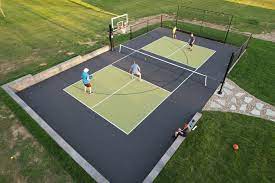Pickleball has quickly become one of the most popular sports, attracting players of all ages. For communities, schools, and homeowners, having a high-quality court is essential for safety, performance, and long-term enjoyment. Understanding pickleball court construction and working with professional pickleball court builders ensures a durable, safe, and enjoyable playing environment. This guide explores the key aspects of building a top-quality pickleball court.
Importance of Professional Pickleball Court Construction
A properly constructed pickleball court is more than just a flat surface. It involves careful planning, site preparation, and attention to detail. Professional construction ensures the court meets official dimensions, provides consistent ball bounce, and offers a safe playing experience. High-quality courts also require minimal maintenance and can withstand outdoor conditions, including sun, rain, and temperature fluctuations.
Key elements of pickleball court construction include:
- Site Preparation: Selecting a level area with proper drainage is crucial. Uneven terrain or poor drainage can lead to water accumulation, cracking, and uneven surfaces.
- Sub-Base Construction: A solid foundation of crushed stone, gravel, or asphalt provides stability and supports the surface material. This ensures the court remains even and durable for years.
- Surface Installation: The choice of surface material affects performance and maintenance. Options include acrylic coatings, synthetic modular tiles, rubberized surfaces, or concrete/asphalt with top coating. Each material offers different levels of traction, shock absorption, and durability.
- Additional Features: Proper fencing, lighting, and seating areas enhance safety and usability, making the court suitable for both recreational and competitive play.
Choosing the Right Pickleball Court Builders
Professional pickleball court builders bring expertise in design, construction, and material selection. Choosing the right builders is crucial for ensuring a high-quality, long-lasting court. Consider these factors:
- Experience and Portfolio: Builders with a proven track record in both residential and community courts can provide quality assurance. Reviewing their past projects helps evaluate their craftsmanship and reliability.
- Customized Solutions: Skilled builders assess the site, usage frequency, and budget to provide tailored recommendations for court design and materials.
- Compliance with Standards: Reputable builders ensure the court meets official pickleball dimensions and safety guidelines.
- Maintenance Guidance: Professional builders provide tips for cleaning, resurfacing, and general upkeep, ensuring the court remains in optimal condition.
Benefits of a Well-Built Pickleball Court
Investing in professional construction and high-quality materials offers several advantages:
- Durability: Proper construction prevents cracks, uneven surfaces, and weather damage.
- Safety: Adequate traction and shock-absorbent flooring reduce the risk of injuries.
- Enhanced Performance: Consistent bounce and smooth surfaces improve the playing experience.
- Long-Term Savings: High-quality construction minimizes repair and maintenance costs over time.
Conclusion
Successful pickleball court construction relies on careful planning, quality materials, and collaboration with experienced pickleball court builders . By focusing on proper site preparation, professional installation, and long-term maintenance, you can create a durable, safe, and enjoyable court suitable for players of all ages. Investing in expertise and high-quality materials ensures that your pickleball facility provides an excellent playing experience for years to come.

